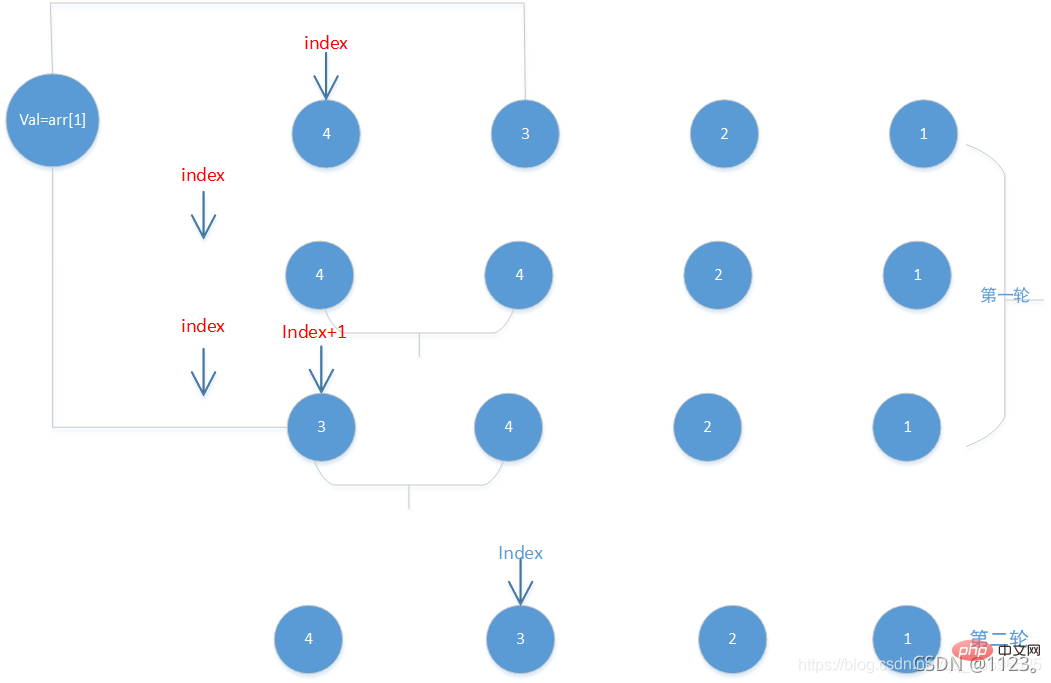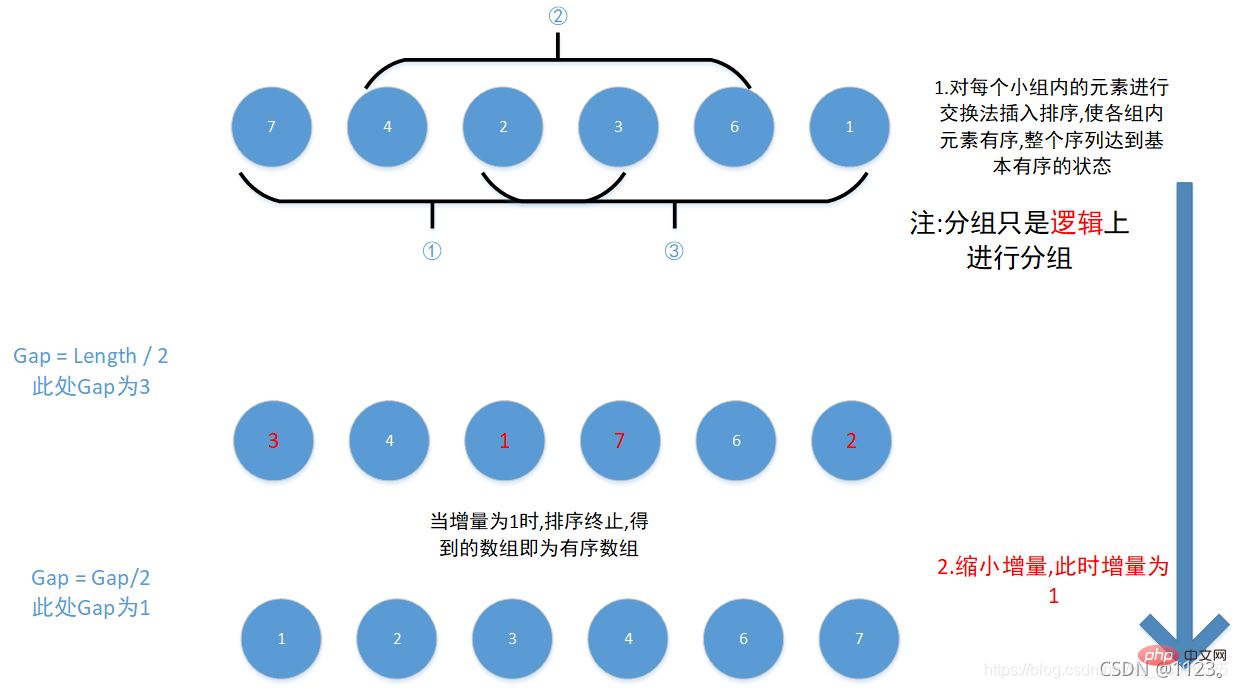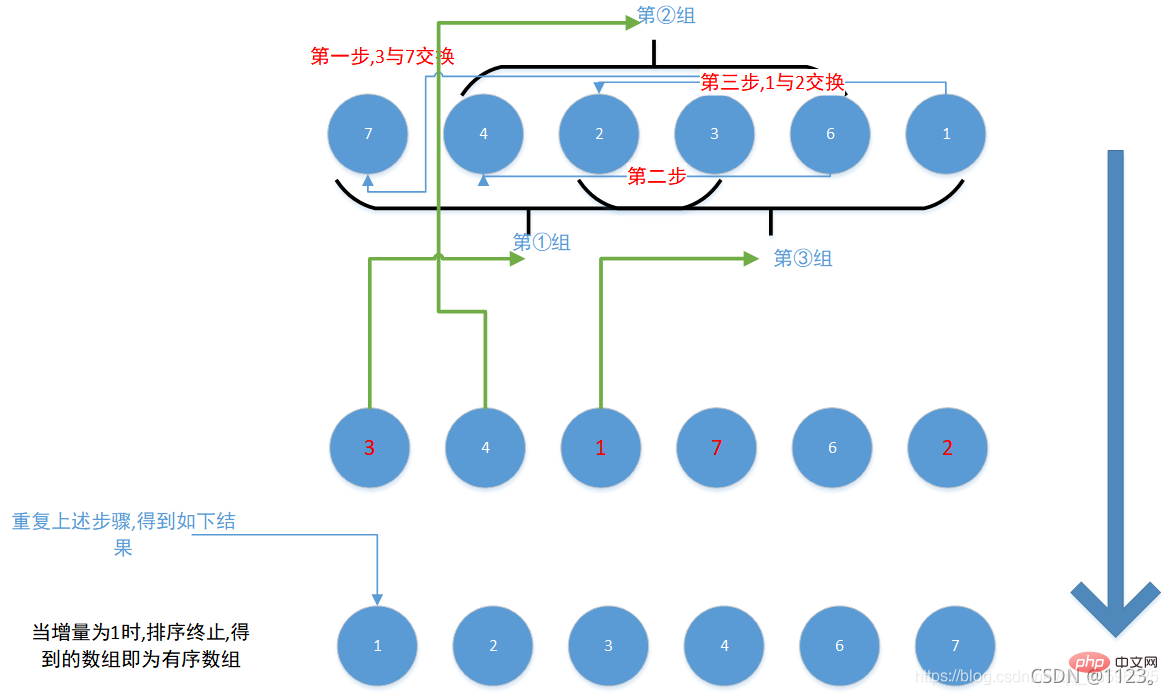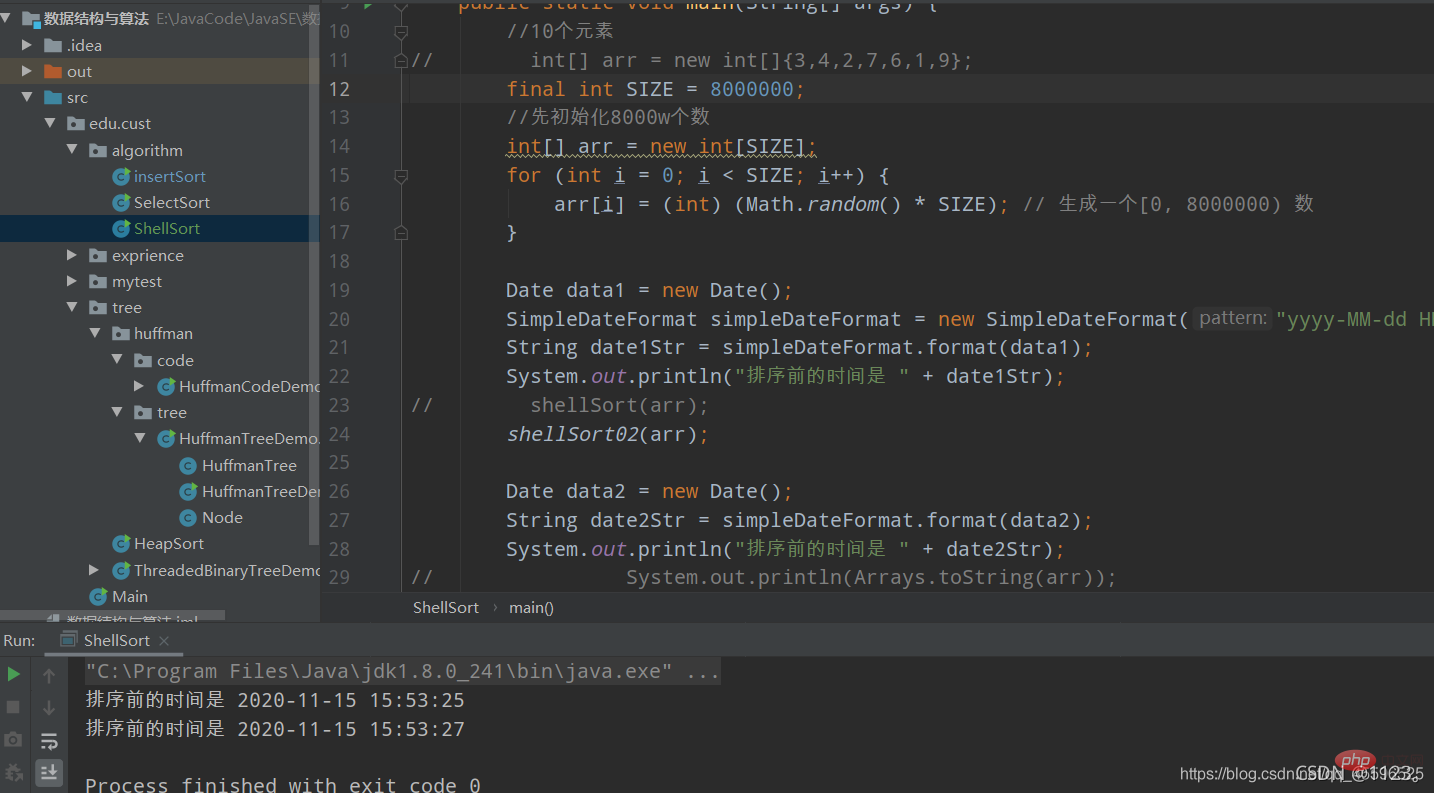How to sort 100 million random numbers in Java?
1. Direct insertion sorting
1. Illustrated insertion sorting
Idea: Literally, insertion is to put an element into a specific in the set, so we need to divide the sequence into two parts, one part is the ordered set, the other part is the set to be sorted
Illustration:

should start from the second element, which is 3To avoid overwriting 3 in subsequent operations, we choose a temporary Variable to save 3. That is,
val=arr[1] above, Since we are operating on the array, we also need to get the end of the
When the cursor
does not cross the boundary, and the value to be inserted is less than the position indicated by the cursor (4 in the above figure) , we move the element 4 back, move the cursor forward, and continue to check whether other elements in the set are smaller than the element to be inserted until the cursor crosses the boundary. , so the loop terminates. The next round of comparison begins2. Code implementation
public static void insertSort(int[]arr){
for(int i = 1 ; i < arr.length; i++){
int val = arr[i];
int valIndex = i - 1; //游标
while(valIndex >= 0 && val < arr[valIndex]){ //插入的值比游标指示的值小
arr[valIndex + 1] = arr[valIndex];
valIndex--; //游标前移
}
arr[valIndex+1] = val;
}
}
12345678910113. Performance testing and time and space complexity
The actual running of 800,000 data takes 1 Minutes and 4 seconds (not an accurate value, each machine may be different)
Direct insertion is more efficient when there are fewer sorting records and the keywords are basically in order. High
Number of keyword comparisons: KCN=(n^2)/2 Total number of moves:
RMN= (n^2)/2So the time complexity is about O(N^2)
2. Hill sorting (exchange method )1. Illustration of ideas
public static void shellSort(int[] arr){ //交换法
int tmp = 0;
for(int gap = arr.length / 2 ; gap > 0 ; gap /= 2){
for(int i = gap ; i < arr.length ; i++){ //先遍历所有数组
for(int j = i - gap ; j >= 0 ; j -= gap){//开启插入排序
if(arr[ j ] > arr[ gap + j ]){ //可以根据升降序修改大于或小于
tmp = arr[gap + j];
arr[j+gap] = arr[j];
arr[j] = tmp;
}
}
}
System.out.println(gap);
System.out.println(Arrays.toString(arr));
}
}
12345678910111213141516 The most difficult thing to understand here should be the third for loop. j = i - gap
The most difficult thing to understand here should be the third for loop. j = i - gap, represents the first element in the group, that is,
j=0,When the first element in the group is greater than the second element (Due to the logical classification, the index of the second element should be the increment gap of all values of the first element), exchange the two, otherwise
, continue to compare or jump out of the loop, After traversing all the groups in this way, reduce the increment (i.e. gap/=2), and then continue the above steps until the increment gap When it is 1, the sequence sorting ends
3. Time complexityThe time complexity of Hill sorting depends on
, which requires detailed analysis of specific issues , is not a definite value, which is also the fourth point that needs to be discussed
4. About the choice of incrementWhen we do the above sorting
Increment reductionThe model chosen is
gap/=2. This is not the optimal choice. The selection of increments is an unsolved problem in the mathematical communitybut it can be determined. Yes, it has been proven through a large number of experiments that when n->infinity, the time complexity can be reduced to:
##In the next point,
, we have also done several experiments. We can be sure that for calculations within a certain scale (such as 800w~100 million),  the speed of Hill sorting far exceeds that of heap sorting
the speed of Hill sorting far exceeds that of heap sorting
3. Hill sorting (shift method)The exchange method is much slower than the shift method, so it is more Use the shift method
, and the shift method is more "like" insertion sorting than the exchange method1. IdeaThe idea is actually the above two sorting methods Combining the advantages of grouping
andinsertion
is very efficient.embodies the idea of divide and conquer, combining a relatively Cut a large sequence into several smaller sequences
2. Code implementation
public static void shellSort02(int[] arr){ //移位法
for(int gap = arr.length/2 ; gap > 0 ; gap /= 2){ //分组
for(int i = gap ; i < arr.length ; i++){ //遍历
int valIndex = i;
int val = arr[valIndex];
if(val < arr[valIndex-gap]){ //插入的值小于组内另一个值
while(valIndex - gap >=0 && val < arr[valIndex-gap]){ //开始插排
// 插入
arr[valIndex] = arr[valIndex-gap];
valIndex -= gap; //让valIndex = valIndex-gap (游标前移)
}
}
arr[valIndex] = val;
}
}
}
123456789101112131415163. Experimental results

The above is the detailed content of How to sort 100 million random numbers in Java?. For more information, please follow other related articles on the PHP Chinese website!

Hot AI Tools

Undresser.AI Undress
AI-powered app for creating realistic nude photos

AI Clothes Remover
Online AI tool for removing clothes from photos.

Undress AI Tool
Undress images for free

Clothoff.io
AI clothes remover

Video Face Swap
Swap faces in any video effortlessly with our completely free AI face swap tool!

Hot Article

Hot Tools

Notepad++7.3.1
Easy-to-use and free code editor

SublimeText3 Chinese version
Chinese version, very easy to use

Zend Studio 13.0.1
Powerful PHP integrated development environment

Dreamweaver CS6
Visual web development tools

SublimeText3 Mac version
God-level code editing software (SublimeText3)

Hot Topics
 1389
1389
 52
52
 Perfect Number in Java
Aug 30, 2024 pm 04:28 PM
Perfect Number in Java
Aug 30, 2024 pm 04:28 PM
Guide to Perfect Number in Java. Here we discuss the Definition, How to check Perfect number in Java?, examples with code implementation.
 Weka in Java
Aug 30, 2024 pm 04:28 PM
Weka in Java
Aug 30, 2024 pm 04:28 PM
Guide to Weka in Java. Here we discuss the Introduction, how to use weka java, the type of platform, and advantages with examples.
 Smith Number in Java
Aug 30, 2024 pm 04:28 PM
Smith Number in Java
Aug 30, 2024 pm 04:28 PM
Guide to Smith Number in Java. Here we discuss the Definition, How to check smith number in Java? example with code implementation.
 Java Spring Interview Questions
Aug 30, 2024 pm 04:29 PM
Java Spring Interview Questions
Aug 30, 2024 pm 04:29 PM
In this article, we have kept the most asked Java Spring Interview Questions with their detailed answers. So that you can crack the interview.
 Break or return from Java 8 stream forEach?
Feb 07, 2025 pm 12:09 PM
Break or return from Java 8 stream forEach?
Feb 07, 2025 pm 12:09 PM
Java 8 introduces the Stream API, providing a powerful and expressive way to process data collections. However, a common question when using Stream is: How to break or return from a forEach operation? Traditional loops allow for early interruption or return, but Stream's forEach method does not directly support this method. This article will explain the reasons and explore alternative methods for implementing premature termination in Stream processing systems. Further reading: Java Stream API improvements Understand Stream forEach The forEach method is a terminal operation that performs one operation on each element in the Stream. Its design intention is
 TimeStamp to Date in Java
Aug 30, 2024 pm 04:28 PM
TimeStamp to Date in Java
Aug 30, 2024 pm 04:28 PM
Guide to TimeStamp to Date in Java. Here we also discuss the introduction and how to convert timestamp to date in java along with examples.
 Java Program to Find the Volume of Capsule
Feb 07, 2025 am 11:37 AM
Java Program to Find the Volume of Capsule
Feb 07, 2025 am 11:37 AM
Capsules are three-dimensional geometric figures, composed of a cylinder and a hemisphere at both ends. The volume of the capsule can be calculated by adding the volume of the cylinder and the volume of the hemisphere at both ends. This tutorial will discuss how to calculate the volume of a given capsule in Java using different methods. Capsule volume formula The formula for capsule volume is as follows: Capsule volume = Cylindrical volume Volume Two hemisphere volume in, r: The radius of the hemisphere. h: The height of the cylinder (excluding the hemisphere). Example 1 enter Radius = 5 units Height = 10 units Output Volume = 1570.8 cubic units explain Calculate volume using formula: Volume = π × r2 × h (4
 Create the Future: Java Programming for Absolute Beginners
Oct 13, 2024 pm 01:32 PM
Create the Future: Java Programming for Absolute Beginners
Oct 13, 2024 pm 01:32 PM
Java is a popular programming language that can be learned by both beginners and experienced developers. This tutorial starts with basic concepts and progresses through advanced topics. After installing the Java Development Kit, you can practice programming by creating a simple "Hello, World!" program. After you understand the code, use the command prompt to compile and run the program, and "Hello, World!" will be output on the console. Learning Java starts your programming journey, and as your mastery deepens, you can create more complex applications.




